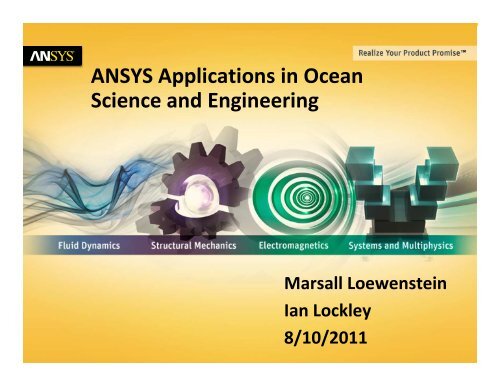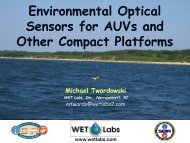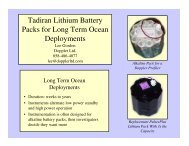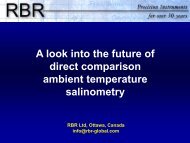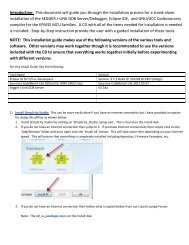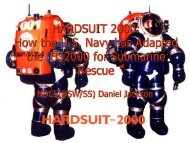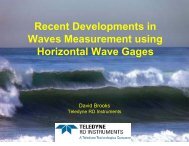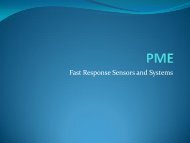ANSYS Applications in Ocean Science and Engineering
ANSYS Applications in Ocean Science and Engineering
ANSYS Applications in Ocean Science and Engineering
Create successful ePaper yourself
Turn your PDF publications into a flip-book with our unique Google optimized e-Paper software.
<strong>ANSYS</strong> <strong>Applications</strong> <strong>in</strong> <strong>Ocean</strong><br />
<strong>Science</strong> <strong>and</strong> Eng<strong>in</strong>eer<strong>in</strong>g<br />
1<br />
© 2011 <strong>ANSYS</strong>, Inc. August 12, 2011<br />
Marsall Loewenste<strong>in</strong><br />
Ian Lockley<br />
8/10/2011
Perspective<br />
The Universe <strong>in</strong> One Year concept was <strong>in</strong>spired by the<br />
late Cornell astronomer, Carl Sagan. Sagan was the first<br />
person to expla<strong>in</strong> the history of the universe <strong>in</strong> one<br />
year—as a “Cosmic Calendar”—<strong>in</strong> his television series,<br />
Cosmos<br />
2<br />
© 2011 <strong>ANSYS</strong>, Inc. August 12, 2011
Perspective<br />
3<br />
© 2011 <strong>ANSYS</strong>, Inc. August 12, 2011
0.5 Seconds of <strong>Ocean</strong>ographic History<br />
11:59:59.5 seconds….<br />
1769<br />
Benjam<strong>in</strong> Frankl<strong>in</strong>’s first scientific study of the Gulf Stream. He measured<br />
water temperatures dur<strong>in</strong>g several Atlantic cross<strong>in</strong>gs <strong>and</strong> effectively<br />
expla<strong>in</strong>ed the phenomena.<br />
4<br />
© 2011 <strong>ANSYS</strong>, Inc. August 12, 2011
5<br />
© 2011 <strong>ANSYS</strong>, Inc. August 12, 2011
0.5 Seconds of <strong>Ocean</strong>ographic History<br />
11:59:59.5 seconds….<br />
1769<br />
Benjam<strong>in</strong> Frankl<strong>in</strong>s first scientific study of the Gulf Stream. He measured<br />
the water temperatures dur<strong>in</strong>g several Atlantic cross<strong>in</strong>gs <strong>and</strong> effectively<br />
expla<strong>in</strong>ed tbe phenomena<br />
1855<br />
Physical Geography of the Sea, by Matthew Fonta<strong>in</strong>e Maury published <strong>in</strong><br />
1855 was the first textbook of <strong>Ocean</strong>ography.<br />
6<br />
© 2011 <strong>ANSYS</strong>, Inc. August 12, 2011
Relevance to <strong>Science</strong> / Eng<strong>in</strong>eer<strong>in</strong>g / Product Design<br />
• The pace of academic endeavors, discovery <strong>and</strong> <strong>in</strong>formation cont<strong>in</strong>ues to<br />
grow at an exponential rate<br />
• Scientists <strong>and</strong> Eng<strong>in</strong>eers are constantly challenged or asked to do more<br />
with less<br />
• Time <strong>and</strong> expense of develop<strong>in</strong>g <strong>in</strong>dustrial <strong>and</strong> research equipment test<br />
must be reduced<br />
• Quality <strong>and</strong> safety must cont<strong>in</strong>ue to rise<br />
• We must all be stewards of our precious environment<br />
• “Cut <strong>and</strong> try” approaches <strong>in</strong> science <strong>and</strong> eng<strong>in</strong>eer<strong>in</strong>g must be<br />
supplemented or replaced with simulation<br />
7<br />
• Many mature software tools exist from <strong>ANSYS</strong>, across an<br />
enormous range of physical discipl<strong>in</strong>es, which enable<br />
research <strong>and</strong> the development <strong>and</strong> test<strong>in</strong>g of both concepts<br />
<strong>and</strong> products through physics based numerical simulation<br />
© 2011 <strong>ANSYS</strong>, Inc. August 12, 2011
Overview<br />
• Brief Introduction to <strong>ANSYS</strong><br />
• Selected Simulation <strong>Applications</strong><br />
– Environmental<br />
– Pollution dispersion, cleanup, scour<strong>in</strong>g,<br />
ocean currents, noise …<br />
– Energy<br />
– Wave energy, tidal energy, energy<br />
environmental impact<br />
– Mar<strong>in</strong>e<br />
– Hull design, propulsion, system design,<br />
sensor design ….<br />
8<br />
© 2011 <strong>ANSYS</strong>, Inc. August 12, 2011
Overview<br />
• Brief Introduction to <strong>ANSYS</strong><br />
• Selected Simulation <strong>Applications</strong><br />
– Environmental<br />
– Pollution dispersion, cleanup, scour<strong>in</strong>g,<br />
ocean currents, noise …<br />
– Energy<br />
– Wave energy, tidal energy, energy<br />
environmental impact<br />
– Mar<strong>in</strong>e<br />
– Hull design, propulsion, system design,<br />
sensor design ….<br />
9<br />
© 2011 <strong>ANSYS</strong>, Inc. August 12, 2011
Who is <strong>ANSYS</strong><br />
Focused<br />
This is all we do: Physics based software simulation tools for<br />
science <strong>and</strong> eng<strong>in</strong>eer<strong>in</strong>g<br />
Capable<br />
2,000 employees<br />
60 locations, 40 countries<br />
Trusted<br />
96 of top 100 FORTUNE 500 <strong>in</strong>dustrials<br />
Proven<br />
Recognized as one of the world’s most <strong>in</strong>novative<br />
<strong>and</strong> fastest-grow<strong>in</strong>g companies*<br />
A 40 year track record of <strong>in</strong>novation<br />
Independent<br />
Long-term f<strong>in</strong>ancial stability<br />
CAD agnostic<br />
10<br />
© 2011 <strong>ANSYS</strong>, Inc. August 12, 2011<br />
*Bus<strong>in</strong>essWeek, FORTUNE<br />
(image of eng<strong>in</strong>eer work<strong>in</strong>g through simulation problem)
One Picture of <strong>ANSYS</strong><br />
<strong>ANSYS</strong> is the lead<strong>in</strong>g provider of<br />
physics based eng<strong>in</strong>eer<strong>in</strong>g<br />
software tools<br />
Paramterization<br />
Fluids<br />
Mesh<strong>in</strong>g<br />
• Structural<br />
• Thermal<br />
• Electromagnetics<br />
<strong>and</strong><br />
• Fluids<br />
CAD<br />
Import<br />
Structural<br />
+<br />
-<br />
u(t)<br />
In-house<br />
D(s) Plant<br />
Solution<br />
y(t)<br />
Emag<br />
Thermal<br />
Workflow<br />
Postprocess<strong>in</strong>g<br />
11<br />
© 2011 <strong>ANSYS</strong>, Inc. August 12, 2011
Industry Lead<strong>in</strong>g Customers<br />
12<br />
© 2011 <strong>ANSYS</strong>, Inc. August 12, 2011
Selected Academic Customers<br />
13<br />
© 2011 <strong>ANSYS</strong>, Inc. August 12, 2011
<strong>ANSYS</strong> Academic Program<br />
Presence<br />
• Academic products used at 2,400 <strong>in</strong>stitutions<br />
worldwide, with nearly 87,000 licensed seats<br />
Value to Industry<br />
• Students tra<strong>in</strong>ed <strong>in</strong> <strong>ANSYS</strong> jo<strong>in</strong> <strong>in</strong>dustry with<br />
experience <strong>in</strong> simulation<br />
• Research use of <strong>ANSYS</strong> helps tackle next-generation<br />
<strong>in</strong>dustry challenges<br />
Software Technology<br />
• Academic partnerships ensure our product<br />
technology leadership<br />
14<br />
© 2011 <strong>ANSYS</strong>, Inc. August 12, 2011<br />
“By embedd<strong>in</strong>g <strong>ANSYS</strong> technology <strong>in</strong> our eng<strong>in</strong>eer<strong>in</strong>g curriculum, Cornell is produc<strong>in</strong>g<br />
students who can go <strong>in</strong>to <strong>in</strong>dustry with a strong foundation <strong>in</strong> the application of<br />
advanced simulation.”<br />
Dr. Rajesh Bhaskaran<br />
Cornell University<br />
<strong>ANSYS</strong> Academic Program<br />
Professor Rajesh Bhaskaran<br />
Cornell University
Typical Mar<strong>in</strong>e CFD <strong>Applications</strong><br />
• Hydrodynamics<br />
• Ship hulls<br />
• Submar<strong>in</strong>es<br />
• Yacht hulls, keels<br />
• Appendages<br />
• Other underwater systems<br />
• Towed sonar arrays<br />
• Propulsion<br />
• Propeller / Hull<br />
<strong>in</strong>teractions<br />
• Water jets<br />
• Cavitation<br />
• Bubble wakes <strong>and</strong><br />
signature<br />
• Acoustics<br />
• Aerodynamics<br />
• Superstructures<br />
• Dispersion<br />
• Yacht Sails<br />
• Exhaust plumes<br />
• Ventilation<br />
• Heli Deck operations<br />
• Fire Suppression<br />
• Halon replacement<br />
• Blast <strong>in</strong>teractions<br />
• Fluid Structure Interaction<br />
• Float<strong>in</strong>g objects<br />
• Flexible objects<br />
• Vortex Induced Vibration<br />
• Swim suits<br />
• Heat transfer<br />
• Fuel Cells<br />
• Wave slam<br />
• Flood<strong>in</strong>g <strong>in</strong> Ro-Ro ferries<br />
• Cavitation<br />
• Torpedoes<br />
• Slosh<strong>in</strong>g <strong>in</strong> tanks<br />
• Submar<strong>in</strong>e Reactors<br />
• Structural vibrations<br />
• Periscope / free surfaces<br />
• Pumps<br />
• Offshore Power<br />
generation<br />
• Chemical reactions<br />
• Free surface flows<br />
• Microfluidics<br />
• Hypersonics<br />
• CVD<br />
15<br />
© 2011 <strong>ANSYS</strong>, Inc. August 12, 2011
Overview<br />
• Brief Introduction to <strong>ANSYS</strong><br />
• Selected Simulation <strong>Applications</strong><br />
– Environmental<br />
– Pollution dispersion, cleanup, scour<strong>in</strong>g,<br />
ocean currents, noise …<br />
– Energy<br />
– Wave energy, tidal energy, energy<br />
environmental impact<br />
– Mar<strong>in</strong>e<br />
– Hull design, propulsion, system design,<br />
sensor design ….<br />
16<br />
© 2011 <strong>ANSYS</strong>, Inc. August 12, 2011
17<br />
© 2011 <strong>ANSYS</strong>, Inc. August 12, 2011
Overview<br />
• Brief Introduction to <strong>ANSYS</strong><br />
• Selected Simulation <strong>Applications</strong><br />
– Environmental<br />
– Pollution dispersion, cleanup, scour<strong>in</strong>g,<br />
ocean currents, noise …<br />
– Energy<br />
– Wave energy, tidal energy, energy<br />
environmental impact<br />
– Mar<strong>in</strong>e<br />
– Hull design, propulsion, system design,<br />
sensor design ….<br />
18<br />
© 2011 <strong>ANSYS</strong>, Inc. August 12, 2011
Environmental: Scour<strong>in</strong>g<br />
19<br />
© 2011 <strong>ANSYS</strong>, Inc. August 12, 2011
Scour<strong>in</strong>g: Challenges<br />
20<br />
© 2011 <strong>ANSYS</strong>, Inc. August 12, 2011
Scour<strong>in</strong>g: Examples<br />
21<br />
© 2011 <strong>ANSYS</strong>, Inc. August 12, 2011
CFD model<strong>in</strong>g of scour around offshore w<strong>in</strong>d turb<strong>in</strong>es <strong>in</strong> areas with<br />
strong currents, Solberg et al, Conference on Offshore W<strong>in</strong>d<br />
Turb<strong>in</strong>es Situated <strong>in</strong> Strong Sea Currents, 2006<br />
22<br />
© 2011 <strong>ANSYS</strong>, Inc. August 12, 2011
Advanced numerical model<strong>in</strong>g of the scour<strong>in</strong>g process<br />
around the piers of a bridge, Motta et al, Proc of the<br />
congress, IAHR, 2007<br />
23<br />
© 2011 <strong>ANSYS</strong>, Inc. August 12, 2011
Illustration Problem<br />
24<br />
© 2011 <strong>ANSYS</strong>, Inc. August 12, 2011
Model<strong>in</strong>g Approach<br />
25<br />
© 2011 <strong>ANSYS</strong>, Inc. August 12, 2011
Initial Results<br />
26<br />
© 2011 <strong>ANSYS</strong>, Inc. August 12, 2011
Numerical simulation of scour around pipel<strong>in</strong>es us<strong>in</strong>g an<br />
Euler-Euler coupled two-phase model, Zhao <strong>and</strong><br />
Fern<strong>and</strong>o, Environmental Fluid Mechanics, (2007)<br />
27<br />
© 2011 <strong>ANSYS</strong>, Inc. August 12, 2011
Environmental: Oil Spill <strong>and</strong> Cleanup<br />
28<br />
© 2011 <strong>ANSYS</strong>, Inc. August 12, 2011
Environmental: Oil Spill <strong>and</strong> Cleanup<br />
29<br />
© 2011 <strong>ANSYS</strong>, Inc. August 12, 2011
CFD Model<strong>in</strong>g of Oil Spill<br />
Past CFD studies employed VOF approach to study oil spill<br />
• Free surface was captured by VOF<br />
• L<strong>in</strong>ear wave profiles was used to describe wave boundary condition<br />
• Studies were limited to 2D<br />
• Studies were conducted for different wavelength <strong>and</strong> amplitude<br />
30<br />
30<br />
© 2011 <strong>ANSYS</strong>, Inc. August 12, 2011
Current CFD Model<br />
Full 3-dimensional Model<br />
Volume of Fluid (VOF) – Approach<br />
• A s<strong>in</strong>gle set of momentum equations is solved <strong>and</strong> the volume<br />
fraction of each immiscible phase is tracked<br />
• Three phases – Air, Water <strong>and</strong> Oil is considered<br />
Open channel wave boundary condition -used<br />
to prescribe wave motion<br />
A fifth order stokes wave theory is used to<br />
describe a non-l<strong>in</strong>ear wave<br />
Turbulence – Realizable k-ε model<br />
31<br />
31<br />
© 2011 <strong>ANSYS</strong>, Inc. August 12, 2011
3D CFD Model<br />
2 Km<br />
Open Channel<br />
Boundary Inlet<br />
Top Surface - Outlet<br />
Open Channel<br />
Pressure Outlet<br />
Oil Spill Location<br />
Oil Inlet<br />
32<br />
32<br />
© 2011 <strong>ANSYS</strong>, Inc. August 12, 2011<br />
Around 565,000 Grid Elements Used<br />
Grid ref<strong>in</strong>ed near sea surface to capture waves
Wave Profiles<br />
5m Amplitude <strong>and</strong> 500m Wavelength Wave<br />
10m Amplitude <strong>and</strong> 500m Wavelength Wave<br />
5m Amplitude <strong>and</strong> 750m Wavelength Wave<br />
33<br />
33<br />
© 2011 <strong>ANSYS</strong>, Inc. August 12, 2011
Wave Profile - Animation<br />
5m amplitude <strong>and</strong> 500m Wavelength wave<br />
34<br />
34<br />
© 2011 <strong>ANSYS</strong>, Inc. August 12, 2011
Wave Velocity Profiles<br />
5m Amplitude <strong>and</strong> 500m Wavelength Wave<br />
10m Amplitude <strong>and</strong> 500m Wavelength Wave<br />
5m Amplitude <strong>and</strong> 750m Wavelength Wave<br />
35<br />
35<br />
© 2011 <strong>ANSYS</strong>, Inc. August 12, 2011
Observations - Velocity Profiles<br />
High velocity near surface due to waves<br />
As wave steepness <strong>in</strong>crease – Non l<strong>in</strong>ear waves results<br />
Coastal region or Shallow water region impacts the wave profile<br />
36<br />
36<br />
© 2011 <strong>ANSYS</strong>, Inc. August 12, 2011
Oil Slick at Sea Surface<br />
5m Amplitude <strong>and</strong> 500m<br />
Wavelength Wave<br />
10m Amplitude <strong>and</strong> 500m<br />
Wavelength Wave<br />
5m Amplitude <strong>and</strong> 750m<br />
Wavelength Wave<br />
37<br />
37<br />
© 2011 <strong>ANSYS</strong>, Inc. August 12, 2011
Time History of Spread<br />
5m amplitude <strong>and</strong> 500m Wavelength wave<br />
10m amplitude <strong>and</strong> 500m Wavelength wave<br />
38<br />
38<br />
© 2011 <strong>ANSYS</strong>, Inc. August 12, 2011
Time History of Spread<br />
5m amplitude <strong>and</strong> 500m Wavelength wave<br />
5m amplitude <strong>and</strong> 750m Wavelength wave<br />
39<br />
39<br />
© 2011 <strong>ANSYS</strong>, Inc. August 12, 2011
Time History of Spread<br />
5m amplitude <strong>and</strong> 500m Wavelength wave<br />
5m amplitude <strong>and</strong> 500m Wavelength wave<br />
0.1m/s - Wave Current<br />
40<br />
40<br />
© 2011 <strong>ANSYS</strong>, Inc. August 12, 2011
Observations<br />
Spread pattern is different for different wave<br />
conditions<br />
Polluted area <strong>in</strong>creases with higher <strong>in</strong>teraction<br />
of wave <strong>and</strong> current<br />
Polluted area is more towards coastal area or <strong>in</strong><br />
shallow water<br />
High wave amplitude – oil traveled faster to the<br />
coastal area – thus not spread<strong>in</strong>g<br />
41<br />
41<br />
© 2011 <strong>ANSYS</strong>, Inc. August 12, 2011
Conclusions<br />
Overview of the oil spill <strong>and</strong> its impact on oil <strong>and</strong> gas<br />
<strong>in</strong>dustry<br />
Physics of oil spill – Hydrodynamics of <strong>Ocean</strong> waves<br />
plays major role<br />
Focused on shallow water waves – Dispersion of oil<br />
slick is more<br />
Need higher order wave theories as wave steepness<br />
<strong>in</strong>crease<br />
42<br />
42<br />
© 2011 <strong>ANSYS</strong>, Inc. August 12, 2011
Conclusions<br />
43<br />
43<br />
Presented a detailed 3D CFD based model for<br />
study of oil spill<br />
• Volume of Fluid (VOF)<br />
• Open channel wave boundary condition<br />
Spread pattern is different for different wave<br />
conditions<br />
Polluted area <strong>in</strong>creases with higher <strong>in</strong>teraction<br />
of wave <strong>and</strong> current<br />
Value of us<strong>in</strong>g CFD based simulations for oil spill<br />
scenarios<br />
© 2011 <strong>ANSYS</strong>, Inc. August 12, 2011
Environmental/Mar<strong>in</strong>e: Noise<br />
44<br />
© 2011 <strong>ANSYS</strong>, Inc. August 12, 2011
Environmental/Mar<strong>in</strong>e: Noise<br />
MENCK hydraulic hammer<br />
45<br />
© 2011 <strong>ANSYS</strong>, Inc. August 12, 2011
Environmental/Mar<strong>in</strong>e: Noise<br />
46<br />
Comparison of measured <strong>and</strong> calculated underwater sound pressure at<br />
a distance of 245 meters from the pile. Know<strong>in</strong>g the sound propagation<br />
law for this region, the sound pressure at 750 meters can be calculated<br />
<strong>and</strong> converted <strong>in</strong>to decibels (dB).<br />
© 2011 <strong>ANSYS</strong>, Inc. August 12, 2011
Environmental/Mar<strong>in</strong>e: Noise<br />
1<br />
2<br />
3<br />
4<br />
5<br />
6<br />
Underwater sound generation <strong>and</strong> propagation<br />
shown as a sequence of snapshots <strong>in</strong> time.<br />
With<strong>in</strong> a steel pile, the speed of sound is about<br />
5,000 meters per second, while the speed of<br />
sound <strong>in</strong> water is about 1,500 meters per<br />
second — result<strong>in</strong>g <strong>in</strong> radiation patterns <strong>and</strong><br />
specific <strong>in</strong>cl<strong>in</strong>ation angle.<br />
47<br />
© 2011 <strong>ANSYS</strong>, Inc. August 12, 2011
Overview<br />
• Brief Introduction to <strong>ANSYS</strong><br />
• Selected Simulation <strong>Applications</strong><br />
– Environmental<br />
– Pollution dispersion, cleanup, scour<strong>in</strong>g,<br />
ocean currents, noise …<br />
– Energy<br />
– Wave energy, tidal energy, energy<br />
environmental impact<br />
– Mar<strong>in</strong>e<br />
– Hull design, propulsion, system design,<br />
sensor design ….<br />
48<br />
© 2011 <strong>ANSYS</strong>, Inc. August 12, 2011
Energy: Wave Energy<br />
49<br />
© 2011 <strong>ANSYS</strong>, Inc. August 12, 2011
Energy: Wave Energy<br />
1 2 3<br />
Wave direction<br />
4 5<br />
COLUMBIA POWER’s wave power system: The w<strong>in</strong>gs <strong>and</strong> vertical spar<br />
react to the shape of the pass<strong>in</strong>g ocean swell. Each w<strong>in</strong>g is coupled by a<br />
drive shaft to turn its own rotary generator.<br />
50<br />
© 2011 <strong>ANSYS</strong>, Inc. August 12, 2011
Energy: Wave Energy<br />
COLUMBIA POWER eng<strong>in</strong>eers doubled<br />
efficiency of the buoy by us<strong>in</strong>g <strong>ANSYS</strong> AQWA to<br />
optimize its geometry.<br />
51<br />
© 2011 <strong>ANSYS</strong>, Inc. August 12, 2011
Energy: Wave Energy<br />
Maxwell computational<br />
electromagnetics software<br />
from <strong>ANSYS</strong> was used to<br />
optimize the generator<br />
design.<br />
52<br />
© 2011 <strong>ANSYS</strong>, Inc. August 12, 2011
Overview<br />
• Brief Introduction to <strong>ANSYS</strong><br />
• Selected Simulation <strong>Applications</strong><br />
– Environmental<br />
– Pollution dispersion, cleanup, scour<strong>in</strong>g,<br />
ocean currents, noise …<br />
– Energy<br />
– Wave energy, tidal energy, energy<br />
environmental impact<br />
– Mar<strong>in</strong>e<br />
– Hull design, propulsion, system design,<br />
sensor design ….<br />
53<br />
© 2011 <strong>ANSYS</strong>, Inc. August 12, 2011
Propulsion Systems<br />
Rolls-Royce uses simulation for propeller design to reduce<br />
mar<strong>in</strong>e fuel consumption.<br />
Accord<strong>in</strong>g to a 2003 study from the University of Delaware, <strong>in</strong>ternational<br />
commercial <strong>and</strong> military shipp<strong>in</strong>g fleets consume approximately 289 million<br />
metric tons of petroleum per year, which is more than twice the consumption of<br />
the entire population of Germany. The <strong>ANSYS</strong> FLUENT simulations run on the<br />
modified propeller geometry predicted that the efficiency would <strong>in</strong>crease by 1<br />
percent to 1.5 percent, <strong>and</strong> physical experiments confirmed that this was, <strong>in</strong><br />
fact, the case.<br />
The new Kamewa<br />
CP-A propeller<br />
from Rolls-Royce<br />
Mar<strong>in</strong>e<br />
54<br />
Contours of pressure coefficient for the XF5 (left) <strong>and</strong> the new Kamewa CP-A (right). Insets: Photographs of the blade <strong>in</strong>dicat<strong>in</strong>g the locations of the<br />
simulation where cavitation is present (noticeable as pitt<strong>in</strong>g). <strong>ANSYS</strong> FLUENT results helped reduce pressure at the blade root <strong>in</strong> the CP-A design, <strong>in</strong>dicated<br />
by the lack of cavitation erosion present <strong>in</strong> the CP-A photo.<br />
© 2011 <strong>ANSYS</strong>, Inc. August 12, 2011
Propulsion Systems<br />
Cavitation Effects<br />
For water pumps, mar<strong>in</strong>e propellers, <strong>and</strong> other<br />
equipment <strong>in</strong>volv<strong>in</strong>g hydrofoils, cavitation can cause<br />
problems such as vibration, <strong>in</strong>creased hydrodynamic<br />
drag, pressure pulsation, noise, <strong>and</strong> erosion on solid<br />
surfaces. Most of these problems are related to the<br />
transient behaviour of cavitation structures. To better<br />
underst<strong>and</strong> these phenomena, unsteady 3D simulations<br />
of cavitat<strong>in</strong>g flow around s<strong>in</strong>gle hydrofoils are often<br />
performed <strong>and</strong> the results are compared to experiments<br />
55<br />
Unsteady propeller cavitation <strong>in</strong> the wake of a ship<br />
© 2011 <strong>ANSYS</strong>, Inc. August 12, 2011<br />
Courtesy SVA-Potsdam (Potsdam Model Bas<strong>in</strong>)
Propulsion (<strong>in</strong>clud<strong>in</strong>g Cavitation)<br />
Cavitat<strong>in</strong>g Flow Over a Hydrofoil<br />
Cavitat<strong>in</strong>g flow over a cambered two-dimensional w<strong>in</strong>g<br />
section was simulated us<strong>in</strong>g <strong>ANSYS</strong> Fluent CFD solver. The<br />
flow angle over the NACA 66 (MOD) hydrofoil is chosen to<br />
represent conditions that are common <strong>in</strong> water pump <strong>and</strong><br />
mar<strong>in</strong>e propeller applications. Excellent agreement with<br />
experimental data is obta<strong>in</strong>ed for mid-chord cavitation, <strong>and</strong><br />
satisfactory agreement is obta<strong>in</strong>ed at the trail<strong>in</strong>g edge of the<br />
cavitation region.<br />
Pressure coefficient as a function of normalized chord length<br />
show<strong>in</strong>g <strong>ANSYS</strong> Fluent results compared with experimental data<br />
Contours of vapour volume fraction show cavitation <strong>in</strong> the mid-chord region<br />
56<br />
© 2011 <strong>ANSYS</strong>, Inc. August 12, 2011
Mar<strong>in</strong>e: Sensor Design<br />
57<br />
© 2011 <strong>ANSYS</strong>, Inc. August 12, 2011
Mar<strong>in</strong>e: Sensor Design<br />
58<br />
© 2011 <strong>ANSYS</strong>, Inc. August 12, 2011
Mar<strong>in</strong>e: Sensor Design<br />
59<br />
© 2011 <strong>ANSYS</strong>, Inc. August 12, 2011
Mar<strong>in</strong>e: Sensor Design<br />
60<br />
© 2011 <strong>ANSYS</strong>, Inc. August 12, 2011
Conclusions<br />
<strong>ANSYS</strong> offers a broad <strong>and</strong> technically deep set of<br />
physics based research <strong>and</strong> eng<strong>in</strong>eer<strong>in</strong>g<br />
software tools which foster underst<strong>and</strong><strong>in</strong>g,<br />
<strong>in</strong>novation as well as save time <strong>and</strong> money<br />
<strong>ANSYS</strong> is a strong partner for both academic <strong>and</strong><br />
<strong>in</strong>dustrial organizations seek<strong>in</strong>g such goals<br />
61<br />
© 2011 <strong>ANSYS</strong>, Inc. August 12, 2011
Thanks You!<br />
Questions?<br />
marshall.loewenste<strong>in</strong>@ansys.com<br />
Ian.lockley@ansys.com<br />
62<br />
© 2011 <strong>ANSYS</strong>, Inc. August 12, 2011


